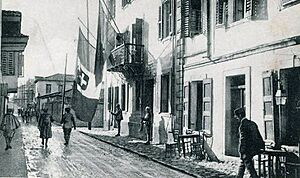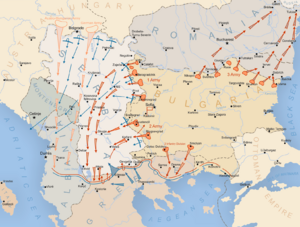Balkans theatre facts for kids
Quick facts for kids Balkans theatre |
|||||||
|---|---|---|---|---|---|---|---|
| Part of the European theatre of World War I | |||||||
|
|||||||
| Belligerents | |||||||
Central Powers:
|
Allied Powers:
|
||||||
| Commanders and leaders | |||||||
|
|
||||||
| Strength | |||||||
| Casualties and losses | |||||||
|
Serbian Campaign:
Macedonian Front: |
||||||
The Balkans Theatre was a major part of World War I. It was fought in the Balkan region of Europe. The main groups fighting were the Central Powers and the Allied Powers.
The Central Powers included Austria-Hungary, Bulgaria, Germany, and the Ottoman Empire. The Allied Powers included Serbia, Montenegro, France, the United Kingdom, Russia, Italy, and later, Greece.
The war in the Balkans started in 1914. Austria-Hungary tried three times to invade Serbia but failed. A year later, in 1915, Austria-Hungary, Germany, and Bulgaria joined forces. They successfully took over Serbia and Montenegro.
The Serbian army did not give up. They bravely retreated through the mountains of Albania. Then, they were taken by ship to Corfu island. A few months later, they regrouped in Salonika (now Thessaloniki, Greece).
On the Macedonian front, the Serbian army joined French and British forces. They fought a long trench war against Bulgarian and German troops. The presence of Allied soldiers in Greece caused a big debate. Greeks argued if their country should join the Allies or stay neutral. Greece finally joined the Allies in 1917.
In September 1918, the Allies launched a big attack called the Vardar Offensive. They broke through the Bulgarian lines, forcing Bulgaria to surrender. After this, Serbia, Albania, and Montenegro were freed.
Contents
Why the War Started in the Balkans
The main reason for the war in the Balkans was the tension between Serbia and Austria-Hungary. Serbia managed to defend itself against Austria-Hungary for over a year. But in late 1915, Serbia was defeated during the Serbian campaign.
Dalmatia was an important area during the war. Both Italy and Serbia wanted to take it from Austria-Hungary. Italy joined the war after signing a deal in 1915. This deal promised Italy a large part of Dalmatia. However, Italy received only a small part of Dalmatia after the war. This made many Italians unhappy.
During World War I, Serbian troops had to escape to Albania. This led the Central Powers to invade Albania. To help the Serbians, Italian ships moved them across the Adriatic Sea. They went to Corfu and other Greek islands. Later, they were moved to Thessaloniki.
Meanwhile, the Allies landed in neutral Greece. They set up the Macedonian front. In 1917, Greece joined the Allies. The Allied army in northern Greece launched an attack in 1918. This attack made Bulgaria ask for peace. It also led to Serbia being recaptured. The Allied advance stopped at the border of Hungary in November 1918.
Serbia and Montenegro Fight Back
Serbian forces bravely defended their country against the larger Austro-Hungarian Army. They were helped because Russia was also attacking Austria-Hungary from the north. In 1915, Austria-Hungary sent more soldiers to the Balkan front. They also got Bulgaria to join the Central Powers.
Soon, the Serbian army was attacked from both the north and the east. This forced them to make a long retreat through Montenegro and Albania. Even though they lost land, the retreat was successful. The Serbian army remained strong and set up a new base in Greece.
Italy's Role in the Balkans

Before officially joining the war, Italy had already taken control of the port of Vlorë in Albania in December 1914. When Italy entered the war, it expanded its control into southern Albania in late 1916. Italian forces even recruited Albanian fighters to help them.
With permission from the Allies, Italy also took over Northern Epirus on August 23, 1916. This made the Greek army leave that area. In June 1917, Italy declared that central and southern Albania were under its protection. Northern Albania was given to Serbia and Montenegro. By October 31, 1918, French and Italian forces had pushed the Austro-Hungarian army out of Albania.
Dalmatia was a very important region during World War I. Both Italy and Serbia wanted to take it from Austria-Hungary. Italy joined the Allies in 1915. This was after they agreed to the London Pact. This agreement promised Italy a large part of Dalmatia if they joined the Allied side.
By November 1918, Italian forces had taken control of all the parts of Dalmatia promised to them. Admiral Enrico Millo even declared himself Italy's Governor of Dalmatia.
Bulgaria Joins the War
After the Balkan Wars, many Bulgarians felt that Russia and the Western powers had not helped them enough. Russia, on the other hand, blamed Bulgaria for starting the Second Balkan War. Russia then saw Serbia as a more reliable friend against Austria-Hungary.
The Bulgarian government decided to side with Germany and Austria-Hungary. This meant they also became allies with the Ottomans, who were traditionally Bulgaria's enemies. Bulgaria could no longer claim land from the Ottomans. However, Serbia, Greece, and Romania still held lands that Bulgarians believed belonged to them. These countries were allies of Britain and France.
Bulgaria had been recovering from the Balkan Wars and stayed out of World War I for the first year. Germany promised Bulgaria all of Serbian Macedonia and parts of northeastern Serbia. Germany also offered a large loan. Because of this, Bulgaria declared war on Serbia in October 1915. Britain, France, and Italy then declared war on Bulgaria.
Bulgaria, allied with Germany and Austria-Hungary, won some battles. They took over much of Southern Serbia, including Niš (Serbia's war capital) in November 1915. They also moved into Greek Macedonia and took Dobruja from the Romanians in September 1916.
However, the war soon became very unpopular with most Bulgarians. They faced huge economic difficulties. In September 1918, Allied forces, including Serbians, broke through the lines on the Macedonian front. This was part of the Vardar Offensive. Even though Bulgarian forces fought hard in the Battle of Doiran, Tsar Ferdinand was forced to ask for peace.
To stop a revolution, Ferdinand gave up his throne to his son Boris III. The revolutionaries were stopped, and their forces were disbanded. Under the Treaty of Neuilly (November 1919), Bulgaria lost its coastline on the Aegean Sea to Greece. It also lost almost all of its Macedonian land to the new state of Yugoslavia. Dobruja was given back to the Romanians.
The Macedonian Front
In 1915, Austria-Hungary got support from Germany and allied with Bulgaria. Serbian forces were attacked from both the north and the south. This forced them to retreat through Montenegro and Albania. Only about 155,000 Serbs, mostly soldiers, reached the coast of the Adriatic Sea. Allied ships then took them to Greece.
The Macedonian front became stable around the Greek border. This happened after French, British, and Italian forces landed in Salonica. The German generals did not let the Bulgarian army advance towards Salonica. They hoped to convince the Greeks to join the Central Powers.
In 1918, after a long build-up, the Allies launched a major attack from Greece. French General Franchet d'Esperey led a combined army of French, Serbian, Greek, and British soldiers. His early victories convinced the Bulgarian government to ask for peace. He then attacked north and defeated the German and Austro-Hungarian forces.
By October 1918, his forces had recaptured all of Serbia. They were ready to invade Hungary. But the Hungarian leaders offered to surrender in November 1918, which stopped the attack.
What Happened After the War
The French and British armies kept six divisions each on the Greek border from 1916 to late 1918. They went to Greece to help Serbia. But after Serbia was conquered in late 1915, their presence there didn't seem to help much. So, they moved some of their forces to the Western Front.
In mid-1918, General Franchet d'Esperey led these forces in a big attack. This attack involved 8 French, 6 British, 1 Italian, and 12 Serbian divisions. They launched a successful attack on September 10, 1918. They freed Belgrade, the capital of Serbia. This forced Bulgaria to agree to a ceasefire on September 29. It also put pressure on Austria-Hungary, which surrendered on November 4, 1918. This also affected the German leaders.
See also
 In Spanish: Frente Balcánico (Primera Guerra Mundial) para niños
In Spanish: Frente Balcánico (Primera Guerra Mundial) para niños


